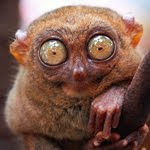In 1944, one of the most devastating years of World War II, Francis Bacon painted Three Studies for Figures at the Base of a Crucifixion. With this horrific triptych depicting vaguely anthropomorphic creatures writhing in anguish, Bacon established his reputation as one of England's foremost figurative painters and a ruthless chronicler of the human condition. During the ensuing years, certain disturbing subjects recurred in Bacon's oeuvre: disembodied, almost faceless portraits; mangled bodies resembling animal carcasses; images of screaming figures; and idiosyncratic versions of the Crucifixion.
 |
| Bacon, Three Studies for a Crucifixion, 1962 Oil with sand on canvas, three panels, 198.1 x 144.8 cm each Solomon R. Guggenheim Museum, New York |
One of the most frequently represented subjects in Western art, the Crucifixion has come to symbolize far more than the historical and religious event itself. Rendered in modern times by artists such as Paul Gauguin, Pablo Picasso, and Barnett Newman, this theme bespeaks human suffering on a universal scale while also addressing individual pain. The Crucifixion appeared in Bacon's work as early as 1933. Even though he was an avowedly irreligious man, Bacon viewed the Crucifixion as a "magnificent armature" from which to suspend "all types of feeling and sensation." It provided the artist with a predetermined format on which to inscribe his own interpretive renderings, allowing him to evade narrative content—he disdained painting as illustration—and to concentrate, instead, on emotional and perceptual evocation. His persistent use of the triptych format (also traditionally associated with religious painting) furthered the narrative disjunction in the works through the physical separation of the elements that comprise them.
That Bacon saw a connection between the brutality of slaughterhouses and the Crucifixion is particularly evident in the Guggenheim's paintings. The crucified figure slithering down the cross in the right panel, a form derived from the sinuous body of Christ in Cimabue's renowned 13th-century Crucifixion, is splayed open like the butchered carcass of an animal. Slabs of meat in the left panel corroborate this reading. Bacon believed that animals in slaughterhouses suspect their ultimate fate. Seeing a parallel current in the human experience—as symbolized by the Crucifixion in that it represents the inevitability of death—he has explained, "we are meat, we are potential carcasses." The bulbous, bloodied man lying on the divan in the center further expresses this notion by embodying human mortality.
Nancy Spector
Source. Nancy Spector, Francis Bacon: Three Studies for a Crucifixion, Guggenheim, New York, Collection Online, accessed 3.3.09.






No comments:
Post a Comment